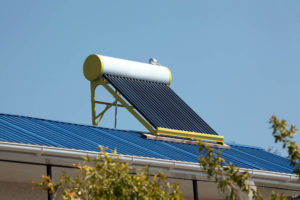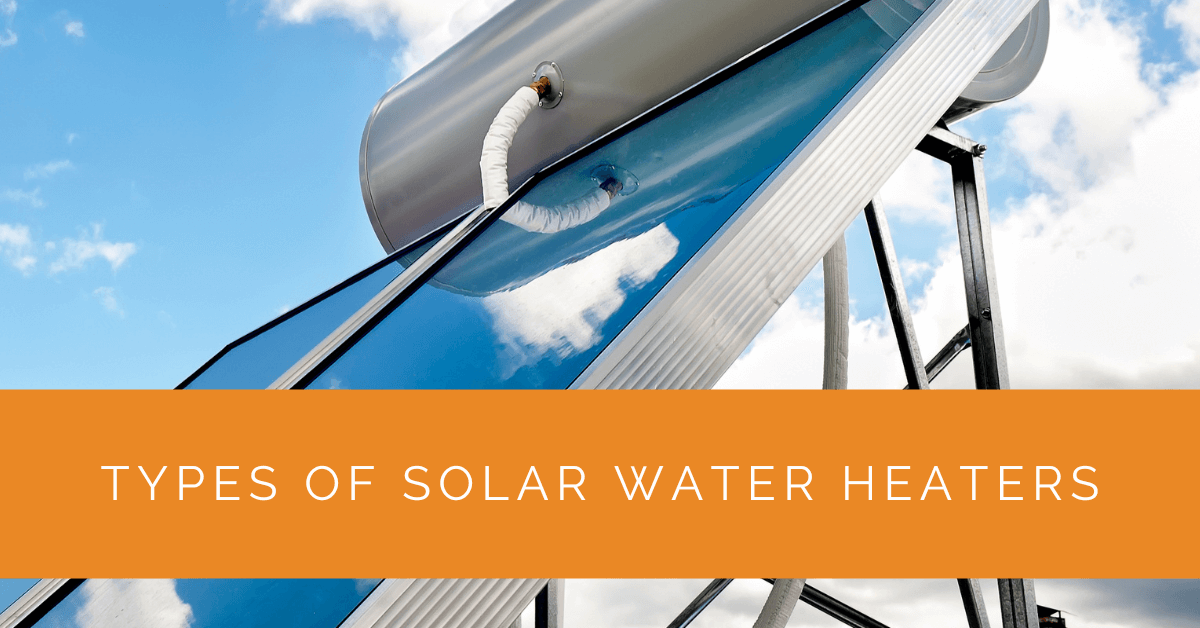The availability of hot water is essential for daily life, and utilizing solar water heaters offers an environmentally friendly and cost-effective solution. This article will explore the different types of solar water heaters available, highlighting their features, applications, and benefits in harnessing solar energy for efficient water heating.
Contents
- 1 Key Takeaways
- 2 Direct Solar Water Heating Systems
- 3 Indirect Solar Water Heating Systems
- 4 Passive Solar Water Heaters
- 5 Choosing the Right Solar Water Heater
- 6 Case Study: Implementing Solar Water Heaters for Residential Use
- 7 Expert Insights From Our Solar Panel Installers About Types of Solar Water Heaters
- 8 Experience Solar Excellence with Us!
- 9 Conclusion
- 10 FAQ
Key Takeaways
- Solar water heaters offer a sustainable and cost-effective solution for hot water, utilizing the sun’s power.
- Different types of solar water heaters, including direct, indirect, and passive systems, provide options to suit various climates, requirements, and budgets.
- Proper system selection, sizing, and professional installation are crucial to ensure optimal solar water heating system performance, efficiency, and longevity.
Direct Solar Water Heating Systems
Thermosiphon System
The thermosiphon system is a popular direct solar water heating system based on natural convection. In this system, a solar collector, typically mounted on the roof, absorbs the sun’s energy and heats the water directly. As the water warms up, it naturally rises into the storage tank at a higher position, while cooler water flows back into the collector to be heated. This continuous circulation occurs without requiring pumps or controls, making the thermosiphon system simple, reliable, and energy-efficient.
Integrated Collector Storage (ICS) System
The Integrated Collector Storage (ICS) system combines the solar collector and the storage tank into a single unit. This type of solar water heating system is often used in warmer climates where freezing temperatures are not a concern. The ICS system allows the water to flow through the solar collector and directly into the storage tank. As sunlight heats the water, it is stored in the tank, ready for use whenever hot water is required. While the ICS system is cost-effective and relatively easy to install, it may experience higher heat loss than other solar water heaters.
Indirect Solar Water Heating Systems
Indirect Closed-Loop System
Indirect closed-loop systems use a heat transfer fluid, such as a mixture of water and antifreeze, to indirectly transfer heat from the solar collector to the water in the storage tank. The heat transfer fluid circulates through a closed-loop pipe network, absorbing heat from the solar collector and then transferring it to a heat exchanger within the storage tank. The heat exchanger, in turn, heats the potable water in the storage tank. This configuration is particularly suitable for areas that experience freezing temperatures as the heat transfer fluid prevents freezing within the system. The closed-loop design ensures efficient heat transfer and greater system installation flexibility.
Indirect Open-Loop System
In contrast to the closed-loop system, the indirect open-loop system separates the potable water from the heat transfer fluid. Potable water flows through a heat exchanger while the heat transfer fluid circulates through the solar collector. As the heat transfer fluid absorbs solar heat, it transfers the heat to the heat exchanger, which, in turn, heats the potable water flowing through it. The heated water is then stored in a separate storage tank for later use. The indirect open-loop system suits areas with water quality concerns or specific regulations regarding direct contact between the solar collector and potable water.

Passive Solar Water Heaters
Batch Solar Water Heater
Batch solar water heaters, batch collectors, or integrated collector-storage (ICS) systems are simple and cost-effective passive solar water heating systems. They consist of a large insulated tank that serves as the solar collector and the storage tank. The tank is placed inside an insulated box with a transparent cover. As sunlight enters the box, it directly heats the water in the tank, which can be used for various applications. Batch solar water heaters are relatively easy to construct and maintain, making them an accessible option for warm climates with consistent solar exposure. However, they may experience heat loss during no hot water demand periods.
Thermosyphon System
The thermosyphon system is a passive solar water heating system that uses natural convection to circulate water. The system consists of a solar collector and a storage tank. As sunlight heats the water in the collector, it becomes less dense and rises into the storage tank above it. Simultaneously, cooler water from the tank flows down to replace the rising warm water in the collector, completing the natural circulation loop. Thermosyphon systems are known for their simplicity, low maintenance requirements, and energy efficiency.
Choosing the Right Solar Water Heater
When considering the installation of a solar water heater, several factors should be taken into account. These include the local climate, hot water demand, available space, and budget. Consulting with a professional solar water heating installer can help determine the most suitable type of solar water heater for specific needs. Proper system sizing, installation, and regular maintenance are crucial to ensuring the solar water heating system’s optimal performance, efficiency, and longevity.
Case Study: Implementing Solar Water Heaters for Residential Use
Background
At Solar Panels Network USA, we are dedicated to providing sustainable energy solutions tailored to our client’s needs. This case study highlights our successful installation of various types of solar water heaters for a residential community, demonstrating the efficiency and environmental benefits of solar thermal technology.
Project Overview
Community Needs and Objectives
A residential community sought to reduce its reliance on conventional water heating methods and lower its overall energy costs. The community’s objectives included implementing a sustainable solution that would provide consistent hot water supply while reducing environmental impact. After a thorough assessment, we recommended a combination of solar water heating systems tailored to the community’s diverse needs and climate conditions.
Implementation
Thermosiphon Systems for Individual Homes
For individual homes with ample roof space and consistent sunlight exposure, we installed thermosiphon systems. These direct solar water heaters utilize natural convection to circulate water, requiring no pumps or controllers. Each system included:
- Solar Collectors: Mounted on the roof to capture and heat water directly.
- Storage Tanks: Placed above the collectors to facilitate natural water circulation.
- Insulation: Ensured minimal heat loss during cooler periods.
The simplicity and reliability of thermosiphon systems made them an ideal choice for these homes, providing an efficient and maintenance-free solution.
Integrated Collector Storage Systems for Multi-Family Units
In multi-family units where space and budget were considerations, we installed Integrated Collector Storage (ICS) systems. These systems combined the solar collector and storage tank into a single unit, streamlining the installation process. Key features included:
- Compact Design: Reduced installation complexity and costs.
- Direct Heating: Allowed for immediate use of heated water, suitable for the region’s mild climate.
- Accessibility: Positioned on rooftops for optimal sun exposure and ease of access for maintenance.
Indirect Closed-Loop Systems for Community Center
The community center, which required a large volume of hot water and operated year-round, was equipped with indirect closed-loop systems. This setup used a heat transfer fluid to prevent freezing and ensure efficient heat transfer. Components included:
- Solar Collectors: Large arrays positioned for maximum sunlight capture.
- Heat Exchangers: Facilitated efficient transfer of heat from the fluid to the potable water.
- Control Systems: Monitored and regulated temperature and flow, ensuring consistent hot water supply.
Results
Energy Savings and Environmental Impact
The implementation of solar water heaters resulted in significant energy savings for the residential community. The thermosiphon and ICS systems provided reliable hot water for individual homes and multi-family units, reducing their electricity bills. The indirect closed-loop systems at the community center ensured a continuous supply of hot water, even during colder months, further lowering energy costs and carbon footprint.
Community Feedback and Satisfaction
Residents reported high satisfaction levels with the new solar water heating systems. They appreciated the consistent hot water supply, reduced energy bills, and contribution to a greener environment. The community center’s staff highlighted the system’s reliability and the minimal maintenance required, emphasizing the positive impact on their operational efficiency.
Summary
Our comprehensive approach to implementing solar water heaters in a residential community demonstrated the versatility and effectiveness of solar thermal technology. By selecting and installing the appropriate systems based on specific needs and climate conditions, we achieved substantial energy savings and environmental benefits. Solar Panels Network USA remains committed to providing tailored solar solutions that meet our client’s unique requirements and promote sustainable living.
Expert Insights From Our Solar Panel Installers About Types of Solar Water Heaters
Choosing the right solar water heater depends on your local climate and hot water needs. Thermosiphon systems are great for regions with consistent sunlight, offering simplicity and reliability without the need for pumps or controllers.
Senior Solar Technician
Integrated Collector Storage systems are a cost-effective option for warmer climates. They combine the collector and storage tank into one unit, making installation straightforward and maintenance minimal.
Solar Energy Consultant
Indirect closed-loop systems are ideal for areas prone to freezing temperatures. By using a heat transfer fluid, these systems prevent freezing and ensure efficient heat transfer even in colder climates.
Commercial Solar Specialist
Experience Solar Excellence with Us!
Trust in Solar Panels Network USA, where our seasoned experts deliver top-quality solar solutions for homes and businesses nationwide. With a legacy of countless successful installations and a commitment to sustainable energy, we’re your reliable partner in the solar journey. Ready for a brighter, eco-friendly future? Call us now at (855) 427-0058 and harness the power of the sun!
Conclusion
Solar water heaters offer an efficient, eco-friendly, cost-effective solution for meeting hot water needs. Whether through direct, indirect, or passive systems, harnessing the sun’s power can provide a sustainable and renewable source of hot water. By understanding the various types of solar water heaters available and considering individual requirements, homeowners and businesses can decide to use solar energy for water heating and contribute to a greener future.
FAQ
What are the different systems of solar water heating?
There are different systems of solar water heating:
- Direct systems include thermosiphon and integrated collector storage (ICS) systems.
- Indirect systems include closed-loop and open-loop systems.
- Passive systems include batch solar water heaters and thermosyphon systems.
Which type of solar heater is best?
The best type of solar water heater depends on climate, hot water demand, available space, and budget. Consulting with a professional installer can help determine the most suitable option for specific needs.
What is the most efficient solar water heater design?
The efficiency of a solar water heater depends on factors like system type, component quality, and proper installation. Indirect closed-loop and thermosiphon systems are generally known for their high efficiency due to effective heat transfer mechanisms and minimal energy losses.
About the Author
Solar Panels Network USA stands at the forefront of solar energy solutions, driven by a team of seasoned solar engineers and energy consultants. With over decades of experience in delivering high-quality solar installations and maintenance, we are committed to promoting sustainable energy through customer-centric, tailored solutions. Our articles reflect this commitment, crafted collaboratively by experts to provide accurate, up-to-date insights into solar technology, ensuring our readers are well-informed and empowered in their solar energy decisions.

